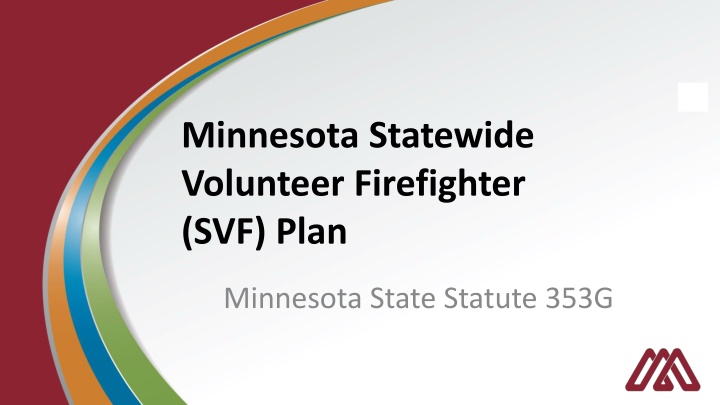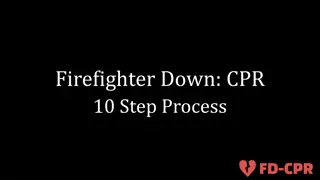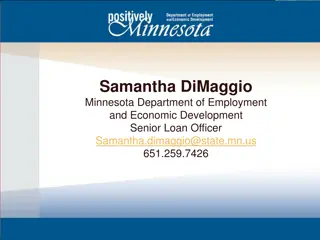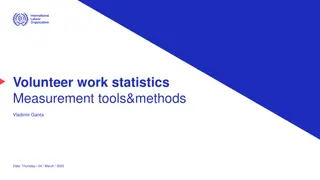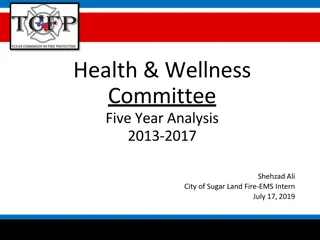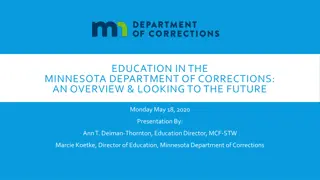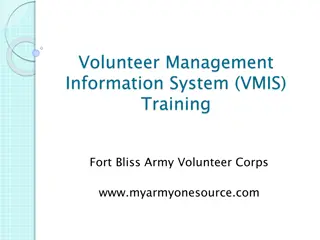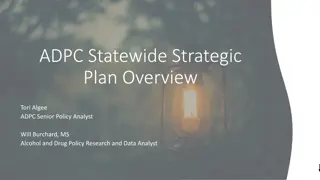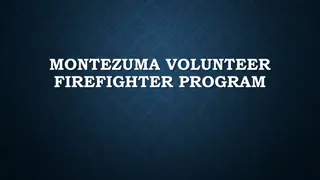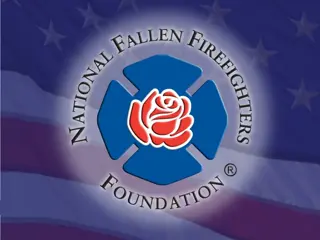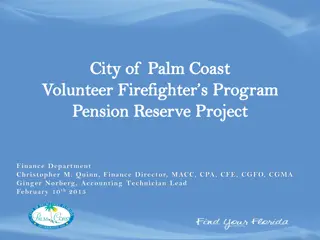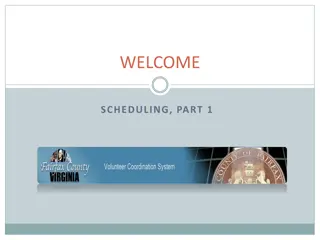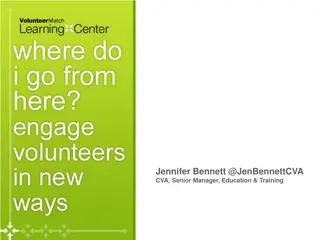Minnesota Statewide Volunteer Firefighter (SVF) Plan Overview
The Minnesota Statewide Volunteer Firefighter (SVF) Plan, established under State Statute 353G, supports volunteer firefighters in over 800 departments with Defined Benefit and Defined Contribution Plans. With advantages like relief from reporting requirements and expertise from the State Board of Investment, the SVF Plan has enrolled 204 departments with 5,400 members. The plan offers portability and low administration fees, aiding in the efficient transfer or termination of accounts when needed.
Download Presentation

Please find below an Image/Link to download the presentation.
The content on the website is provided AS IS for your information and personal use only. It may not be sold, licensed, or shared on other websites without obtaining consent from the author.If you encounter any issues during the download, it is possible that the publisher has removed the file from their server.
You are allowed to download the files provided on this website for personal or commercial use, subject to the condition that they are used lawfully. All files are the property of their respective owners.
The content on the website is provided AS IS for your information and personal use only. It may not be sold, licensed, or shared on other websites without obtaining consent from the author.
E N D
Presentation Transcript
Minnesota Statewide Volunteer Firefighter (SVF) Plan Minnesota State Statute 353G
MNs Volunteer Firefighter Community 800 volunteer fire departments 700 of the departments have a service pension plan Defined Benefit and Defined Contribution Plans The model for the SVF Plan is a Defined Benefit Lump-Sum Plan; which represents the majority of local relief associations.
Definition of Volunteer Firefighter Minnesota State Statute 353G.01, subd.15: volunteer firefighter/ 1. a person who is an active member of a municipal fire department or independent nonprofit firefighting corporation and who, in that capacity
Definition of Volunteer Firefighter engages in fire suppression activities, provides emergency response services, delivers fire education or prevention services on an on-call basis.
Statistics Plan began in 2010 with six departments Today there are 204 departments enrolled 2022 Membership Members 5,400 Assets $152 Million
ADVANTAGES AND DISADVANTAGES
Advantages for Volunteer Departments Relief from annual reporting/audit requirements Transfer of plan administration to PERA Comparable or higher benefits at same cost to the municipality
Advantages for Volunteer Departments Expertise of the State Board of Investment (6% assumed earnings vs. 5%) Portability within SVF Plan Minimal administration and investment fees
Termination or Transfer of Account An entity is eligible to terminate SVF Plan account if it has eliminated its fire department or ceased the services of departing firefighters and has assets to cover all liabilities An entity may initiate the transfer of records, assets, and liabilities to a relief association that will be associated with the entity at the time of transfer
Disadvantages for Volunteer Departments Loss of local plan control Defined contribution option (slice-of-the- pie) is not available
PLAN FUNDING AND ADMINISTRATION
Funding SBI Supplemental Investment Fund Fire Account 6/30 12/31 Fiscal year-end annual return Calendar year-end annual return Cash 5% 2017 10.31% 2017 13.19% Domestic Stock 35% 2018 5.83% 2018 -3.71% 2019 7.34% 2019 18.27% International Stock 15% 2020 4.22% 2020 14.7% Fixed Income 45% 2021 20.8% 2021 9.67% 5-year rate of return 10.2% 5-year rate of return 10.3%
Funding Department accounts funded by: Transferred plan assets Annual fire state aid Required or voluntary contributions Investment earnings
Annual Costs PERA fees: $30/participant Investment fees: $0.06 per $1,000 invested in [6/10ths of 1%]
Governance ADMINISTRATION PERA Board of Trustees/Executive Director Policy-making Management Administration
Governance LEGISLATION SVF Plan Advisory Board Appointed by: Cities (2) Townships (1) Fire Chief (1) Firefighters (2) Firefighter (3) Designee of State Auditor (1) -League of MN Cities -MN Association of Townships -MN State Fire Chiefs Association -Fire Chiefs Association -MN Fire Department Association
STATE STATUTE AND INTERNAL REVENUE CODE PROTECTIONS
Minnesota State Statute 356.63(a) No assets of a public pension plan may be loaned or transferred to the state or a governmental subdivision or be used to amortize an unfunded actuarial accrued liability in another public pension plan or fund.
Exclusive Benefit Rule IRC 401(a)(2) it is impossible for any part of the corpus or income to be used for, or diverted to, purposes other than for the exclusive benefit of his employees or their beneficiaries
Qualifications Coverage to all existing relief associations as well as departments without a retirement plan Joint decision between firefighters and the governing board of the fire department; municipality, independent nonprofit firefighting corporation, joint powers entity
Three easy steps to enroll: Step 1 Request a cost analysis* by providing: members ages and years of service potential benefit level for SVF potential vesting schedule for SVF existing assets * Email PERASVF@mnpera.org to request form
Cost Analysis Table A. Benefit Level (per year of service): A. Benefit Level (per year of service): $500 $900 $600 $1,000 $700 $1,100 $1,000 $1,200 B. Estimated yearly normal cost: G. Estimated yearly admin expenses: H. PERA s administrative cost ($30/firefighter) E. Estimated beginning liability: F. Estimated Deficit Amortization Payment ((E-D)/10): J. Estimated Total Financial Requirement (G+H+I): 7,030 1,030 1.030 419,604 8,386 1,030 1,030 510,997 9,722 1,030 1,030 600,212 13,768 1,030 1,030 659,760 0 0 0 0 $ 5,393 $8,123 $10,853 $13,170 G. Estimated Total Required Contribution (B+C+F): $ 7,690 $9,046 $10,382 $14,428 K. Estimated Fire State Aid: 20,130 20,130 20,130 20,130 13,513 K. Estimated Investment Income (D x 6%): L. Estimated Municipal Required Contribution (J-K): 13,513 13,513 13,513 $ - $ - $ - $ - J. Estimated Municipal Required Contribution (G-H-I): $ - $ - $ - $ - Funding Ratio 129% 117% 108% 101%
Enrollment Step 2 Approval by the governing body and the board of trustees of the relief association, as applicable, before November 30, 2022. Submit board resolutions to notify PERA.
Enrollment Step 3 State Board of Investment reviews individual investments to be liquidated/transferred
Establishment of Account Assets transferred by December 31 Account established January 1
Establishment of Account Relief association must file one last financial report and audit with the state auditor pension division Governing body must continue to apply annually for fire state aid
March 31 Deadline for fire chief to certify good time service credit for previous calendar year March 31 PERA receives supplemental benefit reimbursements
February - May PERA prepares GASB 68 schedules for entities reporting on a GAAP basis. May - June PERA provides an active member service pension report
By August 1 PERA determines and certifies annual funding requirement to governing body PERA invoices governing body for any required contributions due by 12/31 of the following calendar year
October 1 PERA receives fire state aid December 31 Payment due from governing body if required Resolution for an increase due for January 1st effective date
Ongoing Increase of a service pension benefit level: The governing body of a department can change the benefit level once a year to be effective the following January. The governing body or the fire chief may request PERA to provide a cost analysis of an increase. Email PERASVF@mnpera.org to request form
THE FUTURE OF THE RELIEF ASSOCIATION
The Relief Association The membership may maintain or dissolve the association Board membership limited to five people
If Relief Association Maintained Maintain a general fund only The association no longer pays pensions or benefits not authorized as a general fund disbursement under the relief association bylaws
If Relief Association Maintained Fire state aid and contributions from governing body go to PERA The association must update bylaws to reflect these changes
QUALIFICATIONS AND BENEFITS
Retirement Eligibility Minimum age of 50 years old Service meets department s minimum vesting requirement* Separated service for a minimum of 30 days * Good time service is defined by each department
$100 increments $15,000 Benefit Levels Set by the governing body and department Range from $500 - $15,000 per year of good time service credit $900 $800 $700 $600 $500
Benefit Levels May be increased by governing body once per year, effective January 1 No waiting period to request an cost analysis Fire chief or governing body may request cost analysis of an increase
Vesting Schedule A Years 5 6 7 8 9 10 11 12 % Vested 40% 44% 48% 52% 56% 60% 64% 68% Years 13 14 15 16 17 18 19 20 % Vested 72% 76% 80% 84% 88% 92% 96% 100%
Vesting Schedule B Years 5 6 7 8 9 10 % Vested 40% 52% 64% 76% 88% 100%
Vesting Schedule C Years 10 11 12 13 14 15 16 17 % Vested 40% 46% 52% 58% 64% 70% 76% 82% Years 18 19 20 % Vested 88% 94% 100%
Benefit Example Sunfish Fire Department 50-year-old firefighter 20 years of good time service $800 benefit level 20 years x $800/year x 100% = $16,000
Benefit Example: Vesting Schedule A Sunfish Fire Department 50-year-old firefighter 8 years of good time service $800 benefit level 8 years x $800/year x 52% = $3,328
Benefit Example: Vesting Schedule B Sunfish Fire Department 50-year-old firefighter 8 years of good time service $800 benefit level 8 years x $800/year x 76% = $4,864
Benefit Example: Vesting Schedule C Sunfish Fire Department 50-year-old firefighter 8 years of good time service $800 benefit level Did not meet minimum vesting requirement; no benefit
Benefit Example: Portability Sunfish Fire Department $1,000 benefit level Bass Lake Fire Department $2,000 benefit level
Benefit Example: Portability Firefighter retires at age 50 5 years with Sunfish Fire Department 15 years with Bass Lake Fire Department 5 years x $1,000/year x 40% = 15 years x $2,000/year x 100% = $30,000 Lump sum = $32,000 $2,000
